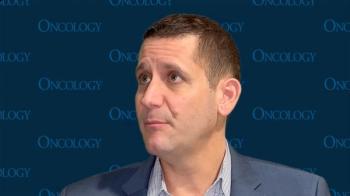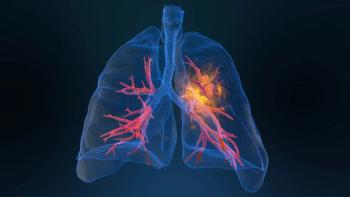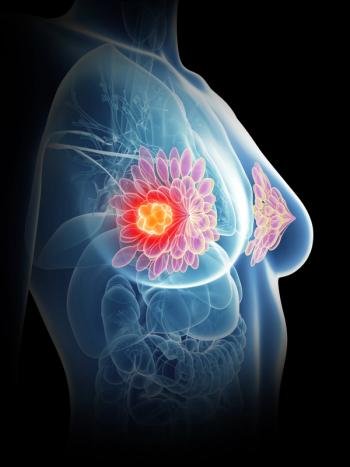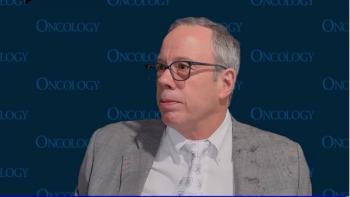
Genomic Features May Define Patient Selection in KRAS-mutated NSCLC
Adagrasib elicited higher efficacy in combination with mTOR inhibitors vs alone when treating patients with KRASG12C-mutant non–small cell lung cancer.
Mutational and non-mutational genomic features, including KEAP1, STK11, andNRF2 statuses, were found to define patients with KRASG12C-mutated non–small cell lung cancer with (NSCLC) with disparate outcomes to G12C inhibition, according to results from an analysis of the phase 1/2 KRYSTAL-1 trial published in Clinical Cancer Research.1
Findings from the trial reveal that patients with KEAP1 or STK11 mutations had significantly worse progression-free survival (PFS) and overall survival (OS) outcomes when treated with adagrasib (Krazati), a G12C inhibitor. For patients with tumors harboring KEAP1 mutations, the median PFS was 4.1 months vs 9.9 months (HR, 2.7; 95% CI, 1.6-4.7; P <.01), and the median OS was 5.4 months and 19.0 months, respectively (HR, 3.6; 95% CI, 2.0-6.6; P <.01).
Additionally, for patients harboring STK11 mutations, the median PFS was 4.2 months vs 11.0 months (HR, 2.2; 95% CI, 1.3-3.6; P < .01), and the median OS was 9.8 months vs not reached (HR; 95% CI, 1.4-4.7; P <.01).
Furthermore, high NRF2 signaling was associated with negative PFS and OS correlations than low NRF2. PFS in tumors expressing high vs low NRF2 status was 4.2 months vs 8.4 months (HR, 2.0; 95% CI, 1.1-3.6; P = .02), respectively. OS in respective groups was 6.5 months vs 19.0 months (HR, 2.8; 95% CI, 1.3-5.7; P <.01).
“KEAP1 and STK11 co-mutations and NRF2 signaling define subgroups of KRASG12C -mutant NSCLC patients with markedly distinct outcomes upon treatment with adagrasib,” Marcelo V. Negrao, MD, assistant professor of the Department of Thoracic-Head and Neck Medical Oncology at the Division of Cancer Medicine at The University of Texas MD Anderson Cancer Center, wrote in the publication with study coinvestigators.
“KEAP1WT/STK11WT/NRF2LOW status – which accounts for 32% of patients – was associated with significant and meaningfully longer survival with adagrasib. These results further support the use of genomic features – both mutational and non-mutational - for selection of standard of care and of investigational therapies for patients with KRASG12C -mutated NSCLC.”
The KRYSTAL-1 cohort included patients with previously treated advanced KRASG12C-mutant NSCLC who received 600 mg oral adagrasib alone twice daily on expansion cohorts 1B and 1A of the trial (n = 129).2 Next-generation sequencing (NGS) was performed in pre-adagrasib treatment samples in 121 patients. All 121 patients had tumor tissue results, and 71 had blood NGS results.
Patients were allocated to co-mutation groups based on the presence or absence of deleterious gene variants. Gene expression profiling was performed in pre-adagrasib tissue samples from 68 patients, encompassing the gene expression evaluable population.
A total of 121 patients were included in the co-mutation analysis as of the data cutoff of October 15, 2021, for the KRYSTAL-1 cohort. Patients in this cohort had a median age of 64 years (range, 25-89), 57% were female, 96% were current or former smokers, and 18% and 82% had ECOG performance status scores of 0 and 1, respectively. Those evaluated had a median of 2 prior lines of therapy.
The most frequently co-mutated genes in the study population were STK11 (47%), TP53 (39%), KEAP1 (30%), ATM (25%), and CDKN2A (22%).
Clinical end points for the study included objective response, PFS, and OS.
Additional findings reveal adagrasib combinations with mTOR or MEK inhibitors showed an improvement in efficacy among H23 and HCC44 cell lines, which are partially sensitive and resistant to adagrasib alone. Additionally, in H23 and H2030 cell lines, adagrasib plus mTORC1/2 inhibitor AZD8055 elicited a significantly reduced surviving cell fraction vs either agent alone, as well as relative to control in 12-day clonogenicity assays.
References
- Negrao MV, Paula AG, Molkentine D, et al. et al. Impact of co-mutations and transcriptional signatures in non-small cell lung cancer patients treated with adagrasib in the KRYSTAL-1 trial. Clin Cancer Res. Published online January 13, 2025. doi:10.1158/1078-0432.CCR-24-2310
- Phase 1/2 study of MRTX849 in patients with cancer having a KRAS G12C mutation KRYSTAL-1. ClinicalTrials.gov. Updated September 20, 2024. Accessed January 29, 2025. https://tinyurl.com/yp7vvf4u
Newsletter
Stay up to date on recent advances in the multidisciplinary approach to cancer.

















































































